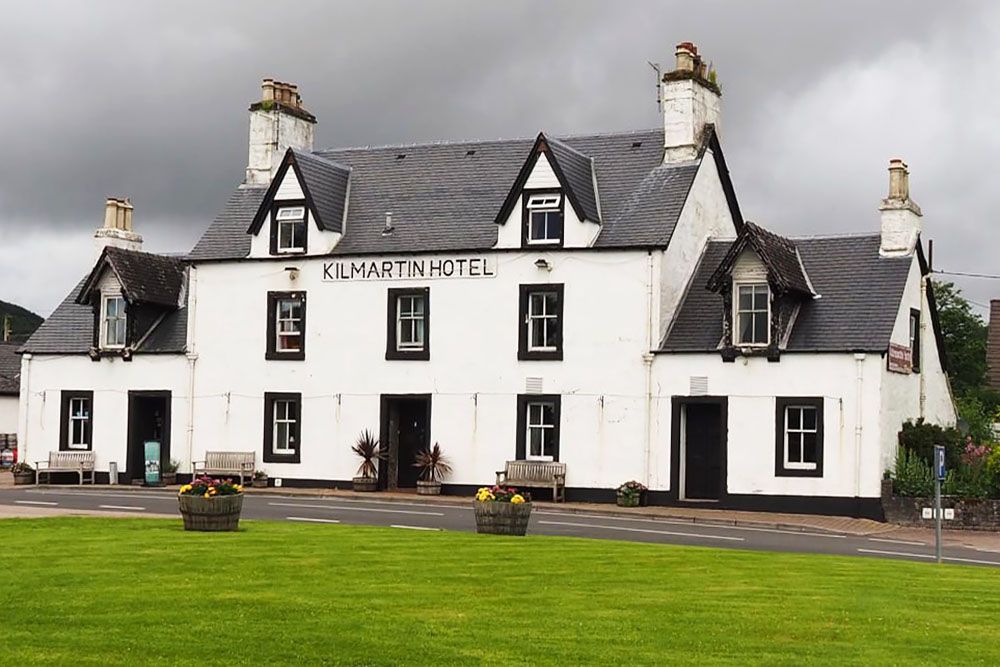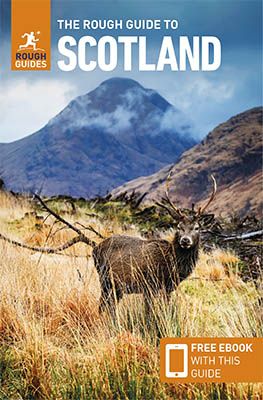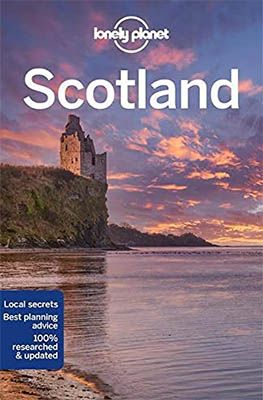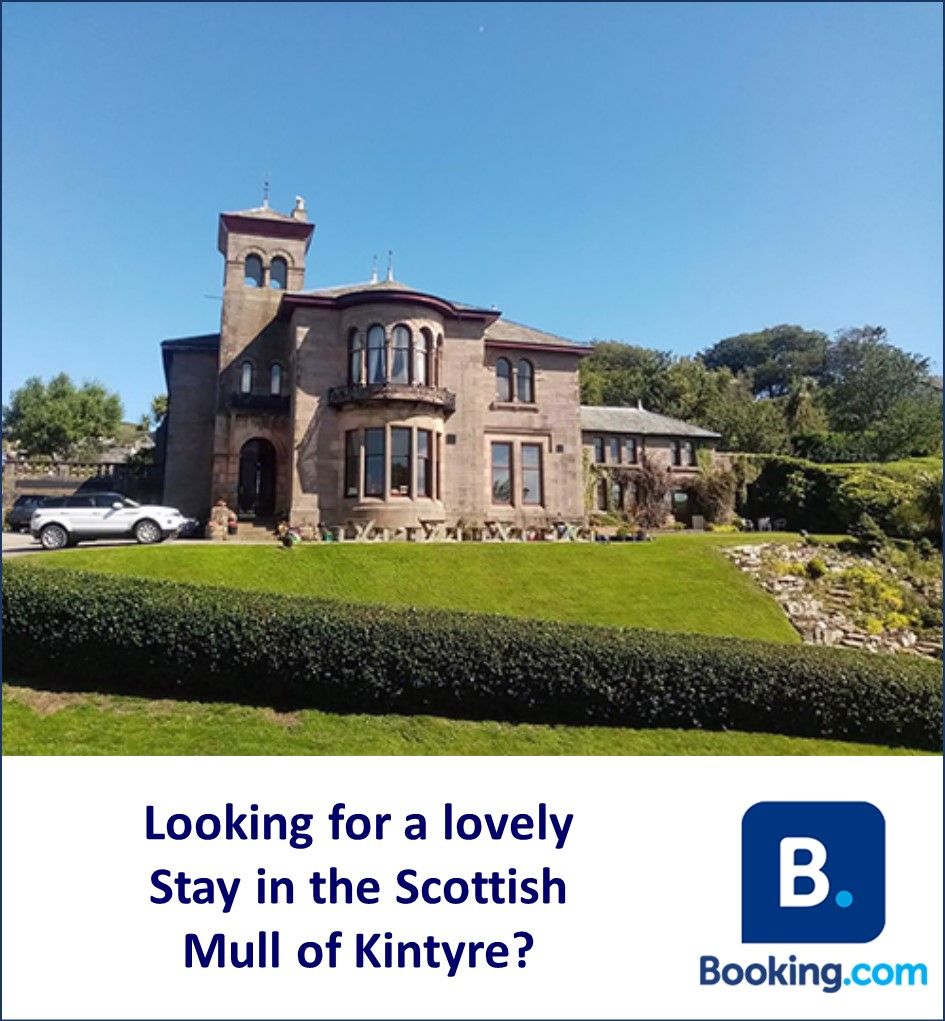On our trip through Scotland, there was one area I absolutely wanted to see. As a fan of Paul McCartney, I had to discover ‘Mull of Kintyre’. The area where he loved to come and still has a home. To get there from Fort William, we took a beautiful road trip along the coast. We passed quaint fishing villages, harbour towns and quiet villages where time seemed to have stood still. We are happy to introduce you to our highlights during our road trip to Mull of Kintyre.
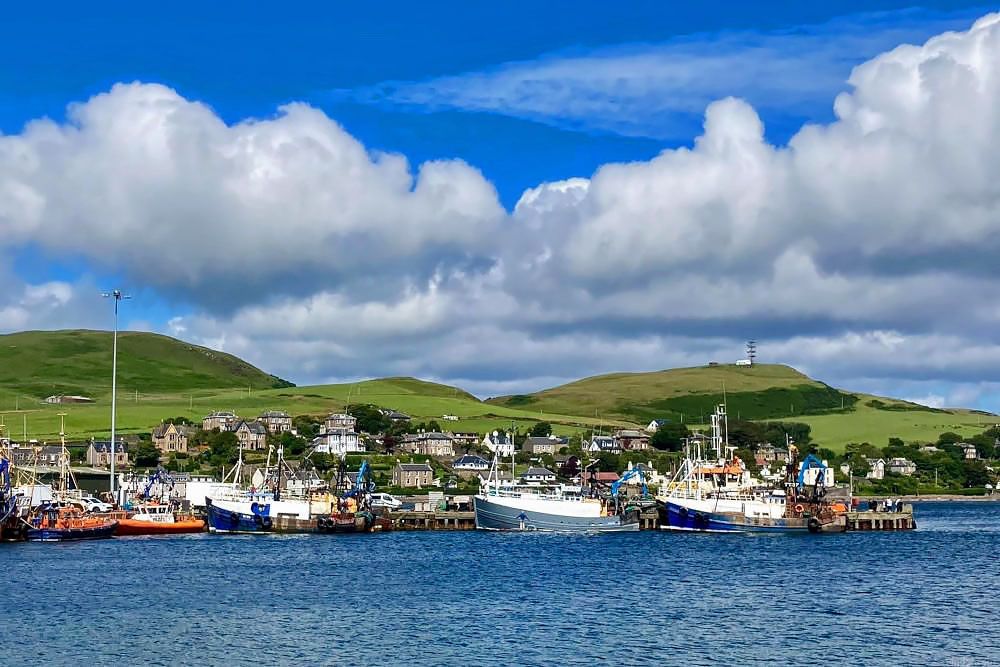
Road trip to Mull of Kintyre from Fort William
Mull of Kintyre is the southern tip of the Kintyre peninsula. That in turn forms part of the Argyll region. That region belongs to the council area of Argyll & Bute. That council area starts just about 30 kilometres south of Fort William, our starting point on this trip. We came across these sights along the way:
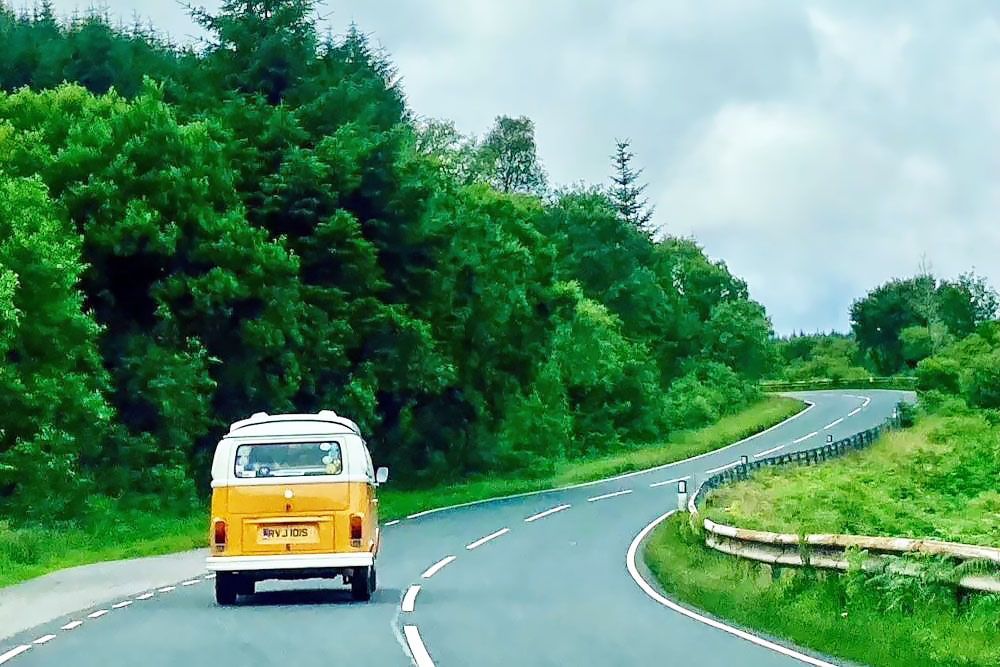
Castle Stalker
Scotland is home to some 3,000 castles. So that we would come across a castle on our road trip to Mull of Kintyre was no surprise. Pretty soon, we hit it. We had only just driven into Argyll & Bute, or we spotted a small island in Loch Linnhe. Castle Stalker dominates this little island. The castle dates back to the 14th century. In the 15th century, the castle took its current form. Unfortunately, the castle is not open to visitors. A pity, because it is picturesquely situated, completely surrounded by water. Fortunately, there is a viewpoint at the nearby Castle Stalker View Café.
Castle Stalker features in one of Monty Python’s hilarious films. In the final scene of the film Monty Python and the Holy Grail, King Arthur besieges the castle. He wants to capture the Holy Grail from the French knights.
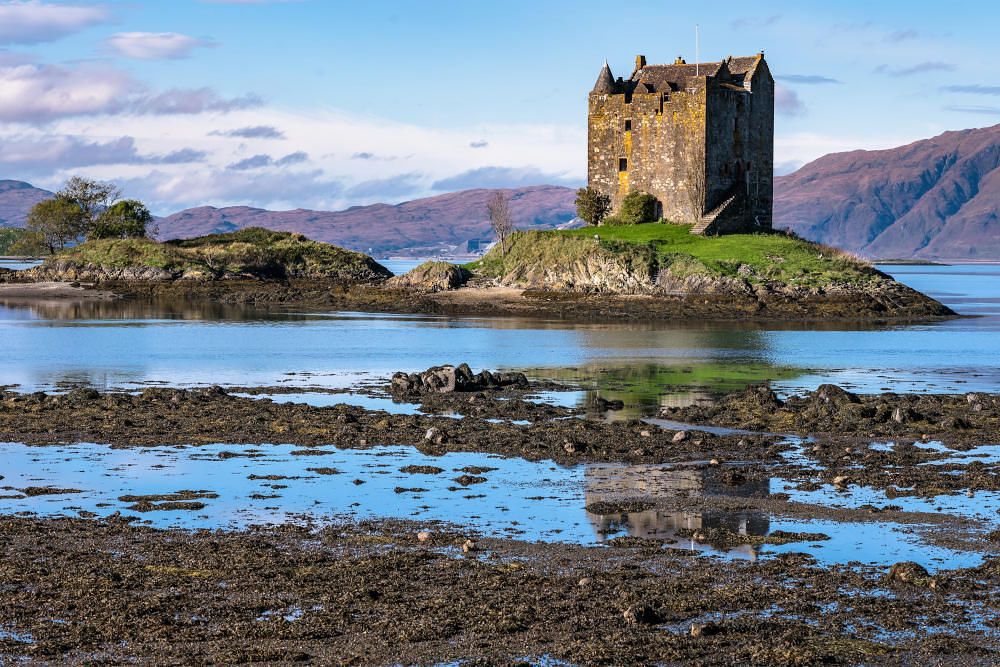
Port town of Oban
Our first stop on our road trip to Mull of Kintyre is the port town of Oban. In the summer months, it is a lively town due to the arrival of many tourists. They take one of the many ferries there to the islands of the Hebrides. Not for nothing is Oban’s nickname ‘the gateway to the isles’.
The view of the harbour is beautiful. Ferries depart or arrive, fishing boats line the quay. We take a walk around the town. One of the places we stop at is Oban Distillery. They have been distilling whisky here since 1794. This makes it one of the oldest distilleries in the country. They live by the motto ‘small but good’. With a team of just seven people, they have managed to make a well-regarded whisky for years.
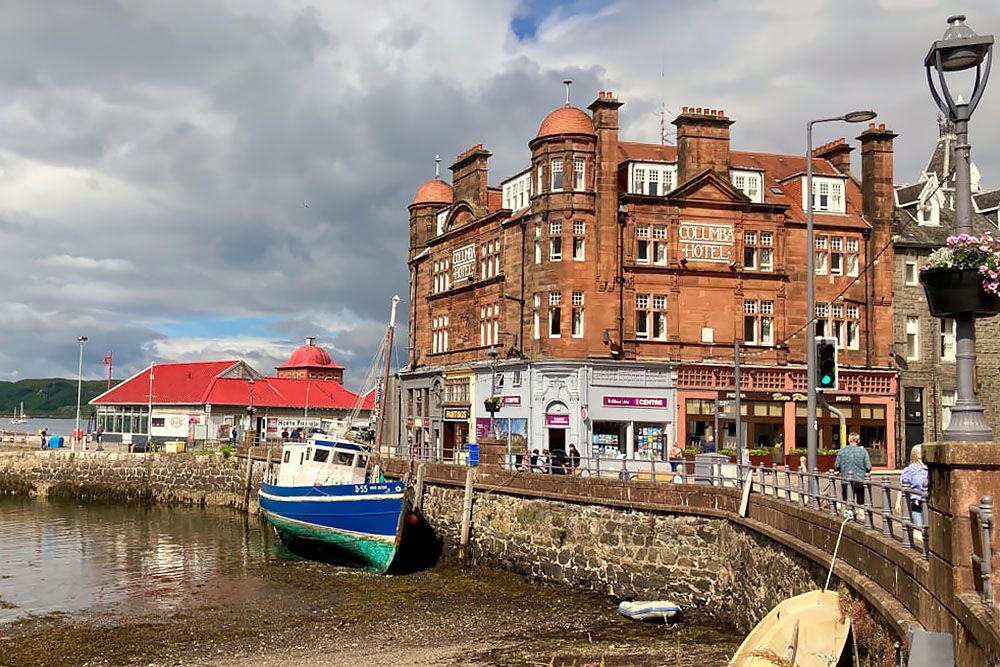
We also walk to a Roman-looking monument high above the city. It looks like the Colosseum in the distance. In reality, it is quite different. It is McCaig’s Tower. Scottish banker John Stuart McCaig had it built. He wanted to turn it into a museum, art gallery and sculpture garden with statues of his family. Due to his death, the plan was never completed; all that stands is a large circular wall resembling a Roman structure. Still, it is worth walking up to it (a 15-minute climb). Because the view from the monument of the city, the port and the bay is so impressive.
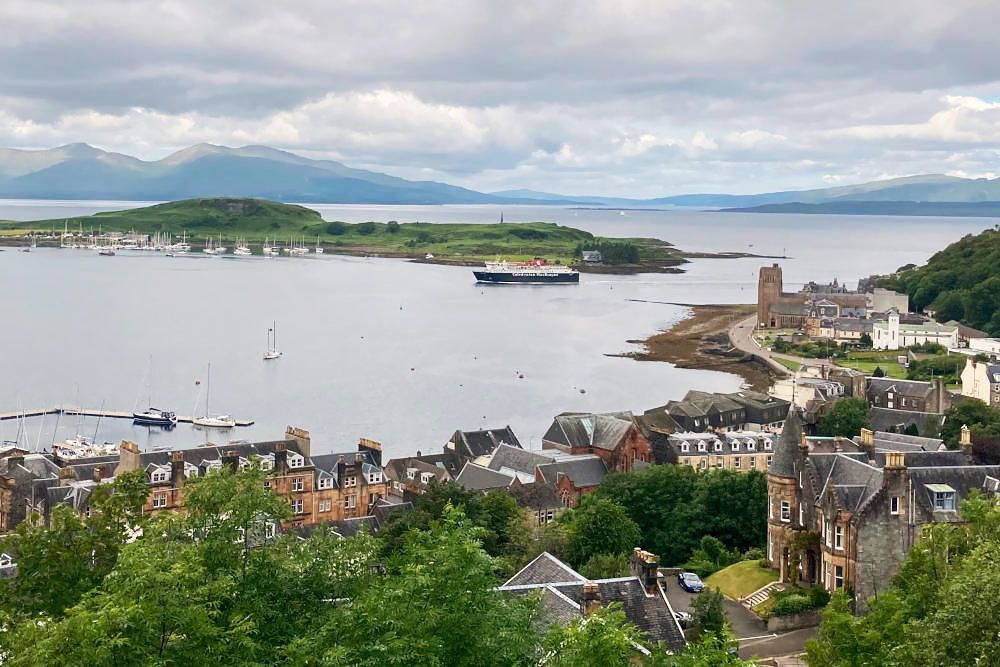
Castles near Oban
If you are love castles, you can visit these two castles near Oban:
Dunollie Castle
Dunollie Castle is a 15th-century castle located less than two kilometres north of Oban. The castle was built by the MacDougall clan. Descendants of this family still own the castle. In the 18th century, the MacDougalls left the castle and built nearby Dunollie House. The castle was no longer maintained and slowly turned into a ruin. Dunollie House now houses a museum. The collection consists mainly of objects collected by Lady Hope MacDougall.
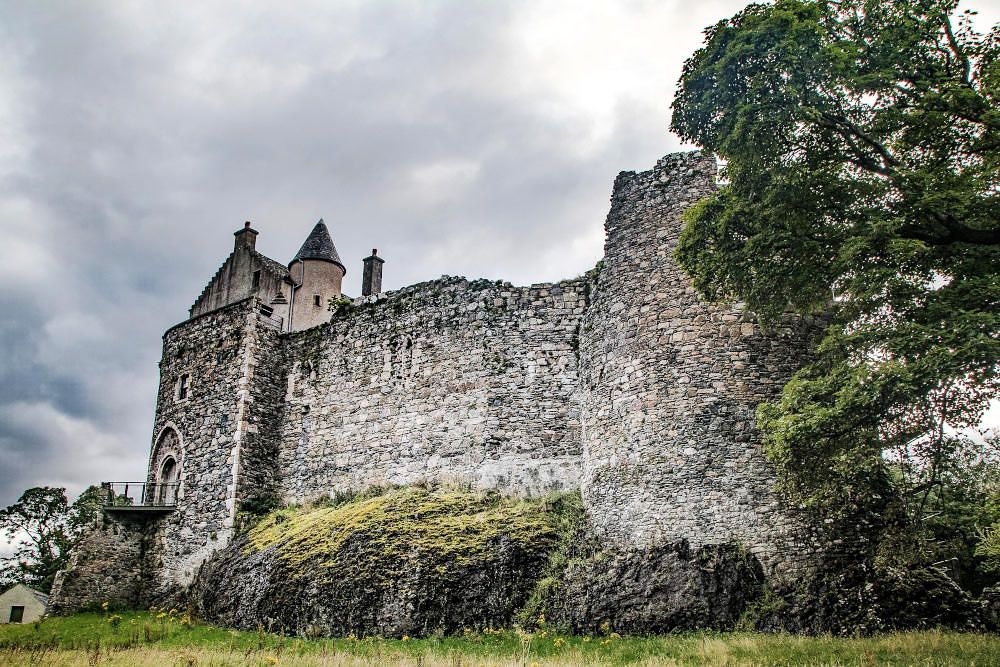
Dunstaffnage Castle
Dunstaffnage Castle was built in the 13th century. It is located about five kilometres north of Oban. Like Dunollie Castle, the castle was owned by the MacDougall clan. In fact, it was the headquarters of this family. Unfortunately, they could not enjoy it for long. Robert the Bruce captured the castle in the 1300s. The castle was then owned by the Scottish royal family for a long time. 150 metres from the castle is Dunstaffnage Chapel. This 13th-century chapel has become a ruin.
Kilmartin
Our next stop is the sleepy village of Kilmartin. Despite it being high season, we hardly meet any other people. We walk around the village and take lots of photos. And we visit the small Kilmartin Museum. This museum has an interesting collection of archaeological finds from the area. For around Kilmartin there are some 350 ancient monuments. Half of these are prehistoric. You will find petroglyphs, tombstones and large standing stones. There is a walking tour of Kilmartin’s main monuments that you can do on your own.
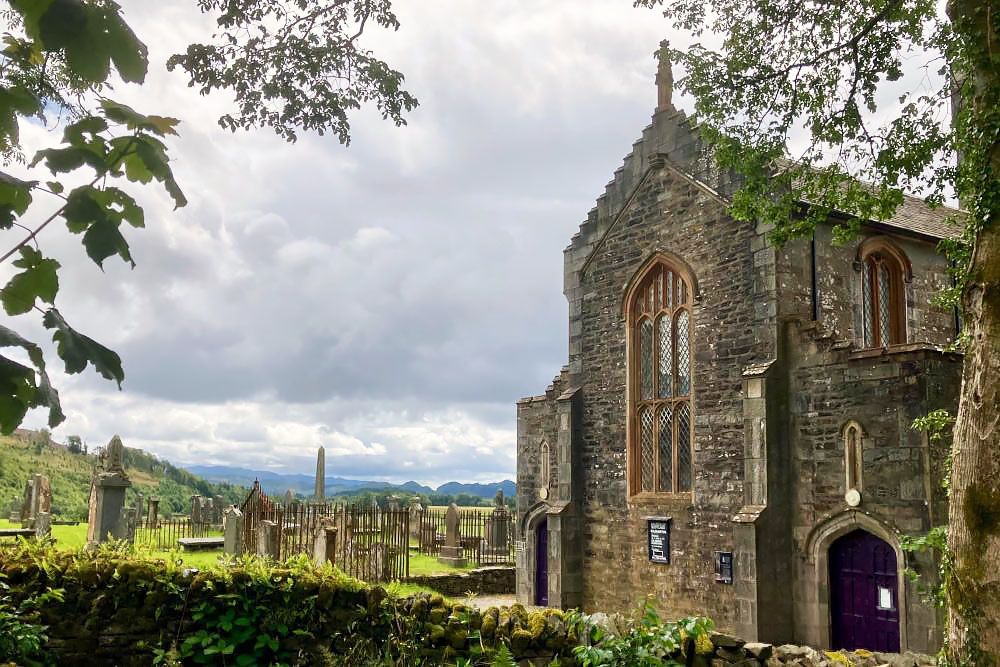
Tarbert
Tarbert on Loch Fyne is the gateway to Kintyre for us. It is a picturesque fishing town. Tarbert’s location is great. On one side rise the rugged hills, on the other we overlook the beautiful natural harbour. Unfortunately, the annual “seafood festival” has just ended. Because that there is a lot of fishing in this place is obvious with all those fishing boats in the harbour.
For the best view of the harbour and bay, you have to climb a bit. There is a signposted path from the port to the ruins of the castle above the town. In the 14th century, this was the castle of Robert the Bruce, the man who defeated the English at Stirling. Not much remains of the structure. Some ruins of the keep are still visible, but they are quite overgrown. Still, the fine views are a reason to take this walk.
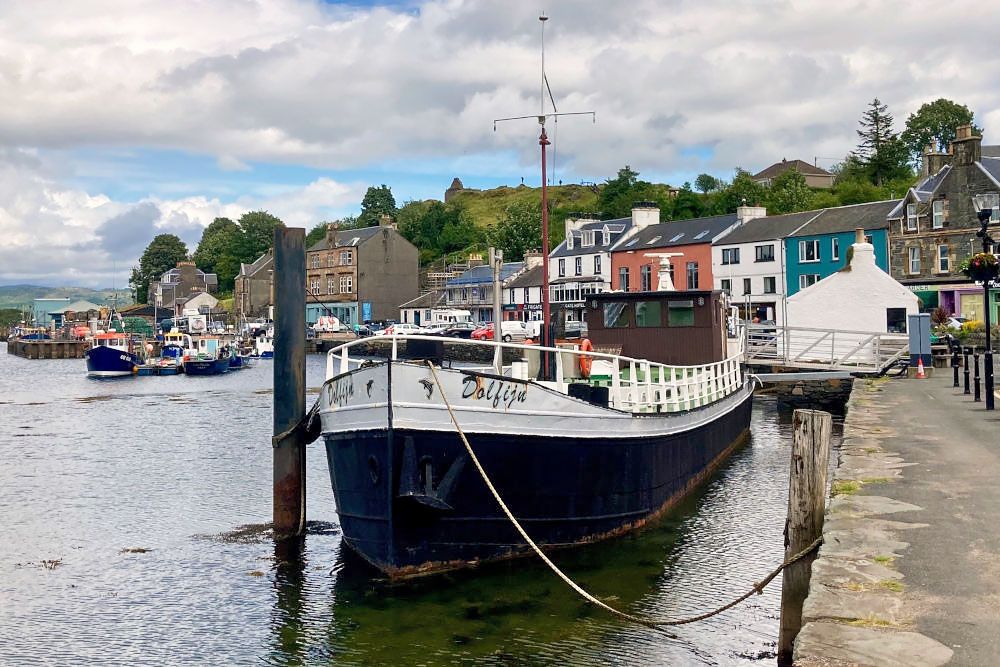
Carradale, base at our road trip to Mull of Kintyre
Little Carradale is the place from which we will further explore Mull of Kintyre. We stay in one of those typical small Scottish hotels. A married couple runs it happily and provides conviviality to guests.
The most striking feature of this picturesque village is its peace and tranquillity. The picturesque but small harbour with a small fishing fleet, stunning views over the Sound of Arran and beautiful Carradale Bay with a wide sandy beach to the south are perfect for walks. We take a not too long but lovely walk there along the bay to Carradale Point. This provides beautiful views.
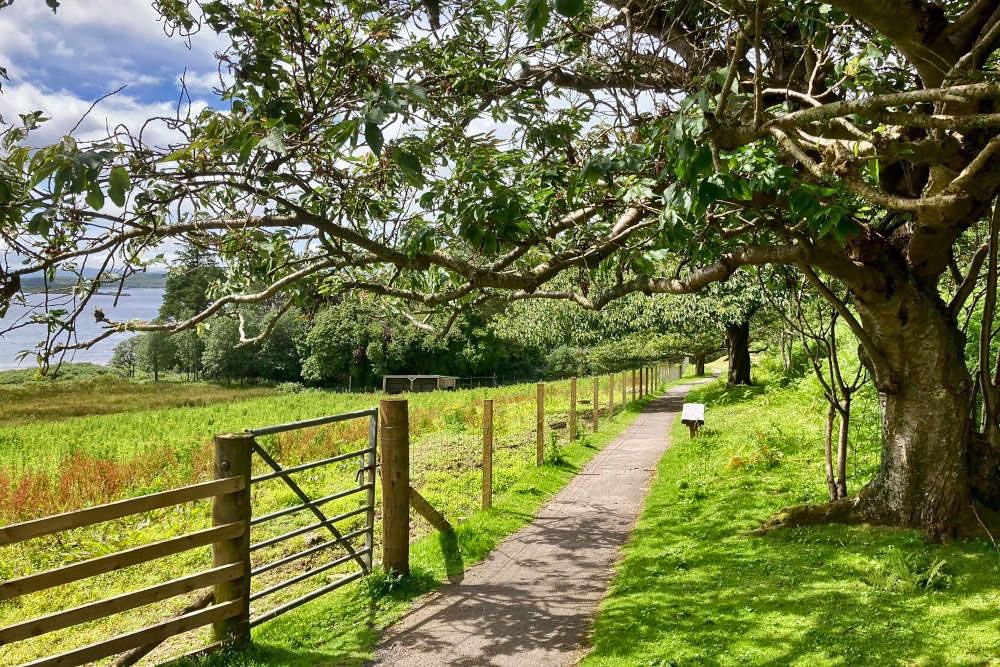
Campbeltown
The peaceful town of Campbeltown is the largest town on the Kintyre Peninsula. It was once the ‘whisky capital of the world’. The town owed that title to the fact that it was home to no fewer than 34 distilleries. Of these, three now remain: Glen Scotia, Glengyle and Springbank. The latter was founded in 1828 and is still owned by the same family. At all these three whisky distilleries, you can take a tour.
We take a short walk through the not-too-large town. First we visit the harbour. There is plenty of activity, many fishing boats sail out or come in. On the quay, fishermen are busy maintaining their nets. In the village, we pass the Linda McCartney Memorial Garden. She and Paul frequented Campbell a lot. They did their shopping there, made friendships and became part of the close-knit community. The local bagpipe band also played along on the song Mull of Kintyre. Linda in particular was very active in setting up social projects in the town. This made her much loved by the locals. After her death, Linda McCartney was honoured with a garden named after her. In it there is also a statue of her.
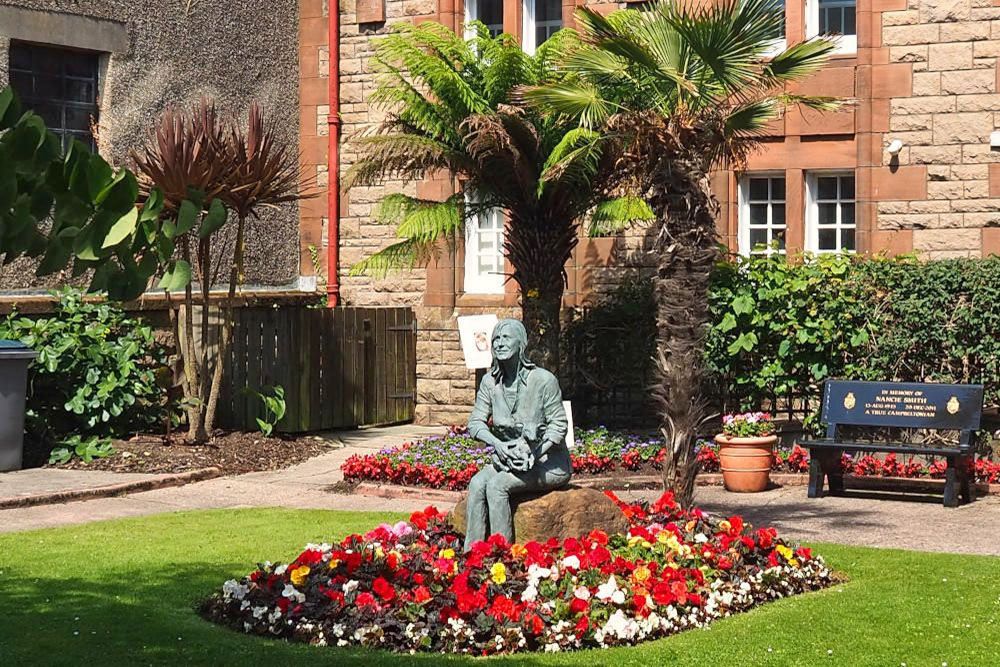
Davaar Island
From Campbeltown harbour, the small island of Davaar is visible. The unique thing about Davaar is that you can walk to it from the mainland. This makes the island one of 17 Scottish islands you can reach on foot. This can only be done if the tide permits. The road is accessible about three hours before and after low tide. Therefore, always check with locals whether it is responsible to start the walk to Davaar. Or ask for the tide table at the small tourist office.
There is a small lighthouse on the island. Around it are a few cottages, which you can rent. If you are looking for peace and quiet, they are ideal accommodations. There are also several sea caves. One of the caves features a mural. At first, Campbeltown residents thought this was a prehistoric work of art. However, it turned out to be the work of a local drawing teacher. The island is a paradise for seabirds. Especially during the breeding season, they flock to Davaar.
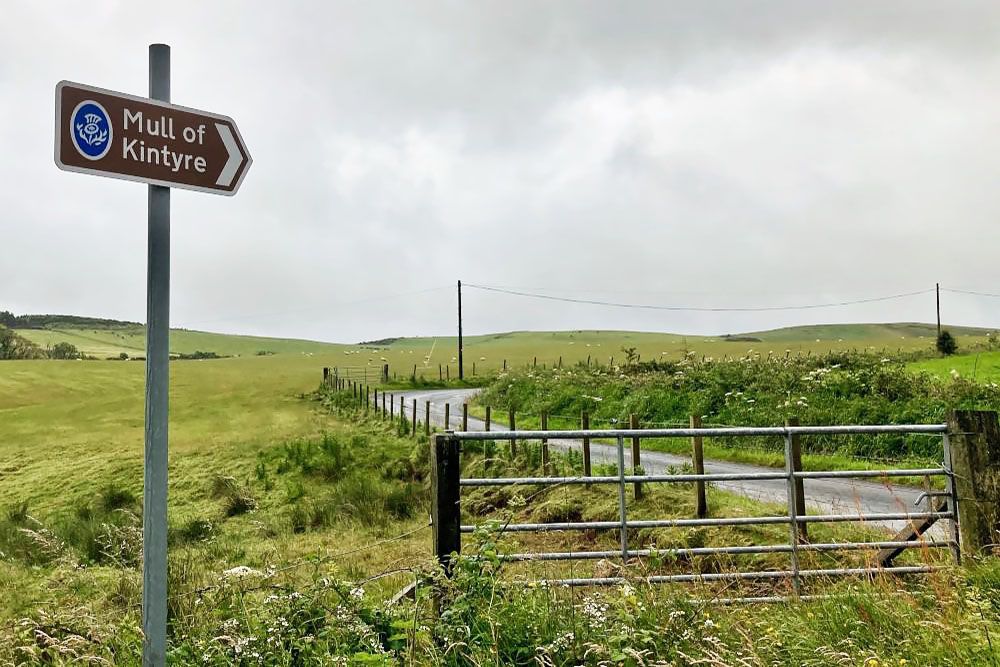
Road trip to Mull of Kintyre Lighthouse
On the last morning, we will set off to reach the most south-westerly point of Kintyre. We will hike the last stretch to the Mull of Kintyre Lighthouse. From there, we should even have a view of the coast of Ireland.
The route from our hotel would be about 50 kilometres. Our hotel manager says we should allow plenty of time for it. “You are entering one of the most desolate areas of the country, with narrow roads where you have to drive slowly. And you will undoubtedly get fog on the way.” We take his advice to heart and leave early. The first stretch to Campbeltown is fairly smooth. Then the roads become more hilly, narrow and winding. The landscape is totally deserted, we meet no one on the way. This must be somewhere where Paul McCartney has his country house where he can live in peace and quiet. It is also where he writes music. Like the ‘Mull of Kintyre’.
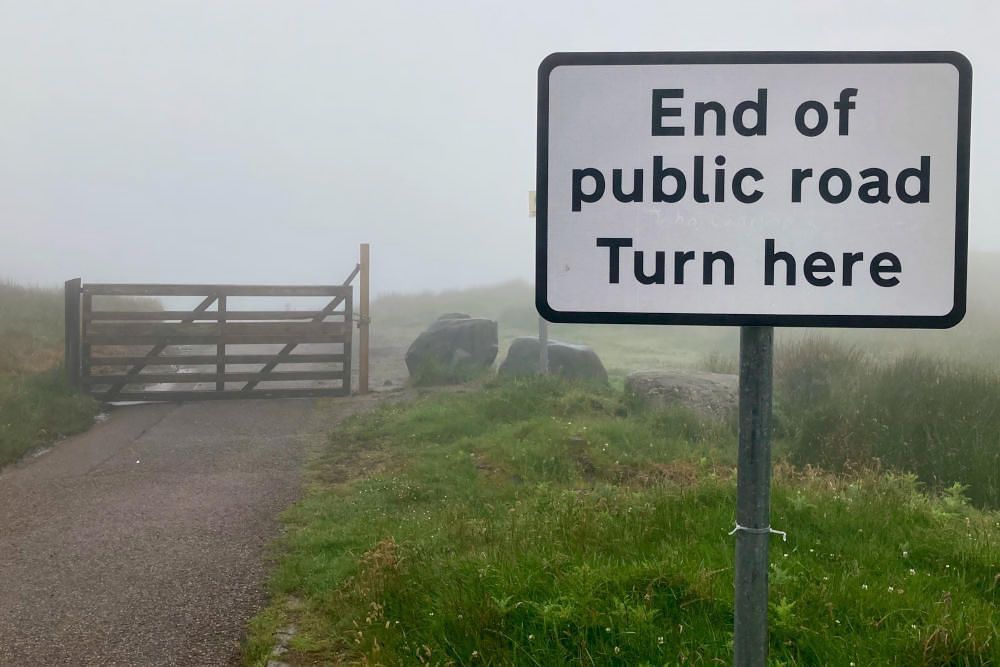
On the way to the car park, a line from that song comes to both of us: “Oh, fog rolling in from the sea.” As the fog is rolling in, we can hardly see our hands in front of our eyes. At walking pace, we drive along winding, hilly and narrow roads. Fortunately, it is so desolate here that we do not meet any oncoming traffic. We reach the empty car park unscathed. Apparently, hordes of tourists do not come to this place, as only a few cars can park there. The sign makes it clear to us that the road ends here. We feel as though we’ve reached the end of the world.
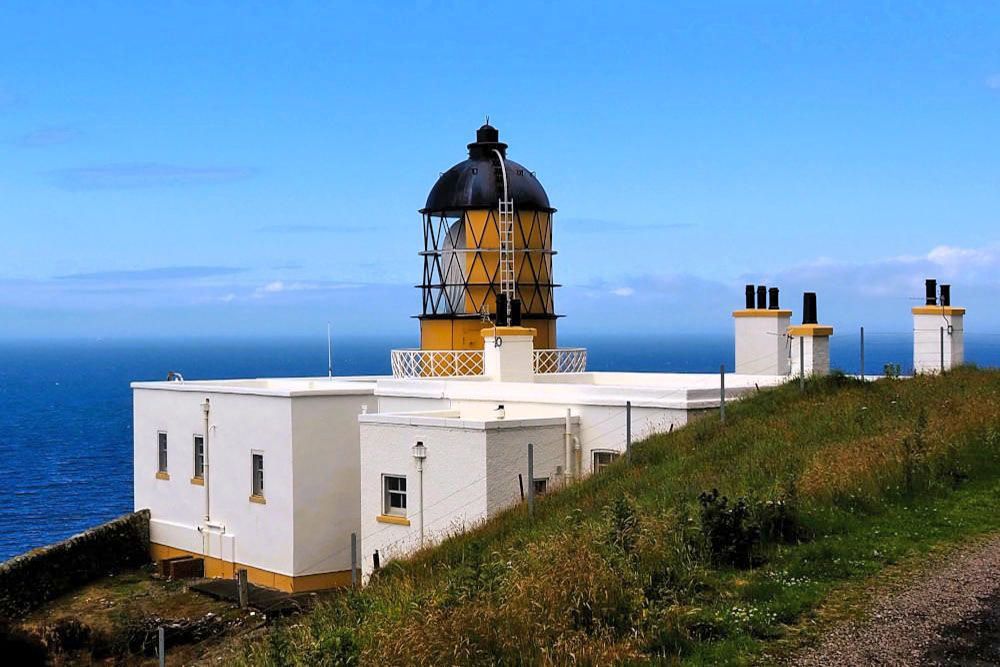
Mull of Kintyre Lighthouse
Our walk to the Mull of Kintyre Lighthouse starts in fog. We hope we can still distinguish the lighthouse in this weather. Seeing Ireland certainly won’t be possible. The route is simple: we follow the tarmac road downhill. We now understand why the road is not open to cars. The road is very steep and zig-zags downhill.
When we are a few bends away, the fog suddenly dissolves and the sun shines brightly. Immediately, the lighthouse below us catches our eye. What luck and what timing! While descending, we reach the lighthouse. Since 1788, its light has been a beacon for ships in the often foggy surroundings. It was once the second lighthouse built in Scotland. The former lighthouse keepers’ cottages are now cottages for rent. No one is there today it seems.
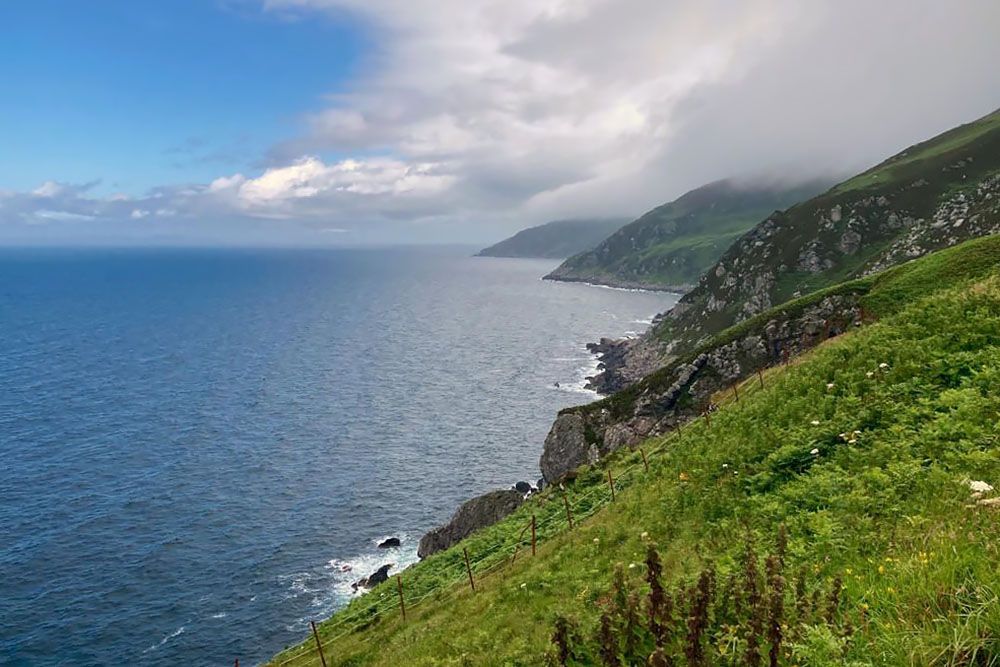
Racing cyclist
Indeed, we can discern the coast of Ireland some 20 kilometres away. We can see the mountains and valleys of Antrim, Fair Head and Malin Head and Rathlin Island. Then we descend some more. This provides a fine view of the deserted coast of Kintyre. This coast inspired Paul McCartney’s 1977 paean to Mull of Kintyre.
When we get back to the lighthouse, we discover a cyclist. He has descended the steep road by road bike. For the way back, he expects to have to walk a lot. With the smallest gear, he won’t be able to make it by bike. On our way back, we take a small path, it leads to a memorial. We read that a Chinook helicopter crashed there in dense fog in 1994. All 29 occupants were killed. We then return to the road and climb to the car park.
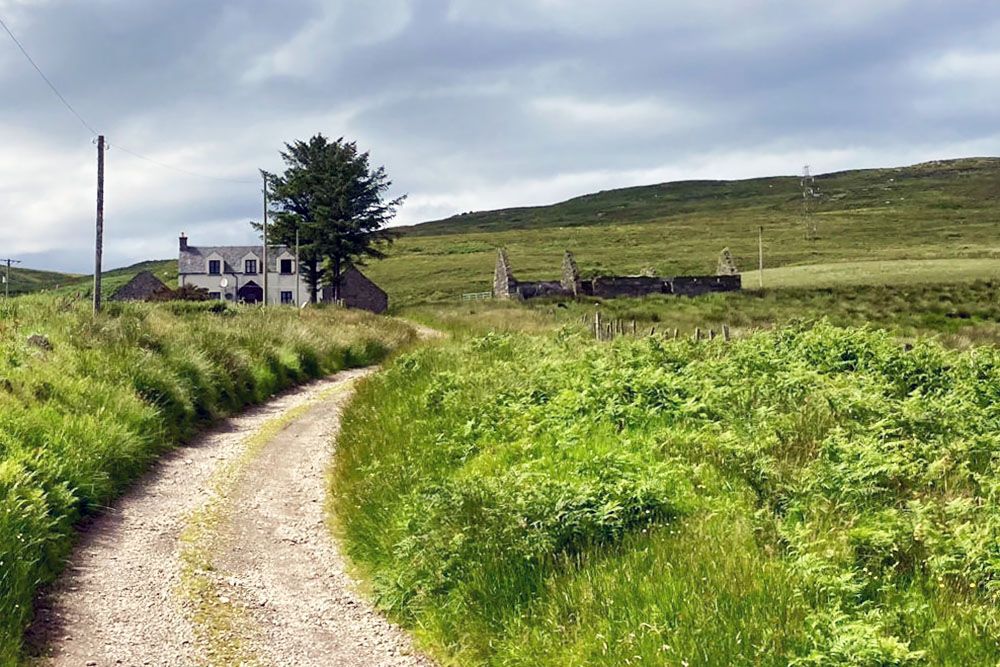
With this road trip to Mull of Kintyre, my wish has been fulfilled. I was able to admire the area in all its beauty and desolation. I can understand why Paul McCartney loves coming here!
All the information for your road trip to Mull of Kintyre
Mull of Kintyre is the southernmost point of the Kintyre peninsula. That in turn forms part of the Argyll region. That region in turn falls into the council area of Argyll & Bute.
As you head towards the Mull of Kintyre, the port town of Oban is undoubtedly the first place you will come across. In and around Oban, you can have an excellent two days. There are two castles nearby. You can take a ferry to one of the islands or enjoy the atmosphere and sights of Oban itself. Other great places to visit include Kilmartin with its nearby prehistoric area Kilmartin Glen, the fishing village of Tarbert, the quiet fishing village of Carradale and the somewhat larger town of Campbeltown. There you will find, among other things, the Linda McCartney Memorial Garden. You can also hike to the small island of Davaar.
The walk is not long and goes along a paved road. The outward route is sharply downhill. Back, you walk the same way and thus climb considerably. This makes the climb difficult. So take plenty of time to rest and take your time on the way up. Fortunately, the climb is only about two kilometres long.
You certainly can. The Kintyre Way runs from the picturesque fishing village of Tarbert in the north to Machrihanish in the south. The entire route is 161 kilometres long. Officially, the Kintyre Way is split into seven stages, but they are rich in scenery. If you want to walk it in full, it's better to assume more walking days with shorter distances. The route is not difficult, except for the last stage. There it is a lot of descending and ascending through rugged terrain.
The route passes through a variety of landscapes, past small fishing villages, extensive pine forests, beaches and stretches of beautiful coastline and open hills and moorlands.
Almost every place we visited has charming cottages, atmospheric bed and breakfasts or cosy hotels.
Oban
If you make a stopover in Oban on your way to Kintyre, it's worth spending the night there. After all, there are many places of interest in and around Oban. These venues score good reviews.
Other accommodation in Oban.
Kilmartin
These are well-reviewed accommodation in Kilmartin.
Tarbert
These lodgings make for a good stay in Tarbert.
Carradale
This small village has two great locations to stay:
- Ashbank Hotel. Cosy and small hotel, run by a couple who go out of their way to give you the ultimate holiday feeling. Fine rooms and an excellent breakfast.
- B&B Drumfearne Tearoom. A beautiful location that serves as a charming B&B with two cosy rooms as well as a tearoom. Delicious dining in atmospheric surroundings. If you're not staying there, you can also eat there. Especially don't skip the dessert. Sign up for dinner at least a day in advance, as seating is limited.
Both venues have a limited number of rooms. So, book in time if you want to stay in Carradale. You won't regret it.
Campbeltown
There is a wide choice in Campbeltown, but these accommodations are sure to have you covered:
This is a list of all accommodations in Campbeltown.
Davaar Island
If you want to experience the ultimate island feeling, then an overnight stay on Davaar Island is for you.
This is an overview of all accommodation on Kintyre.
